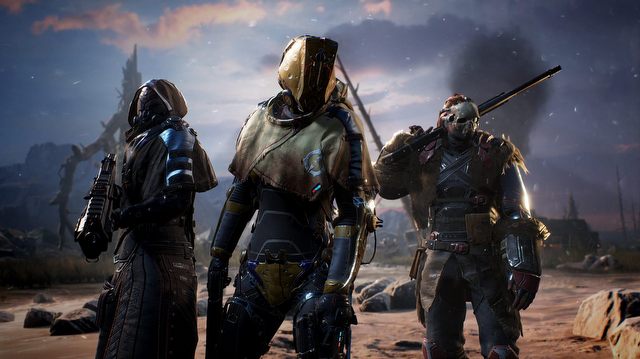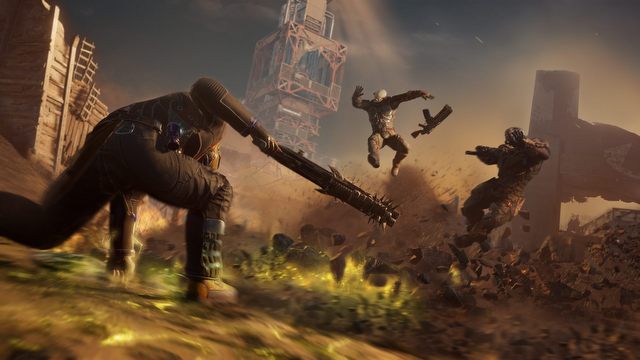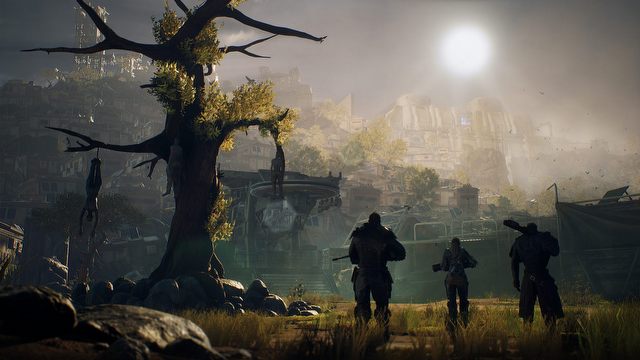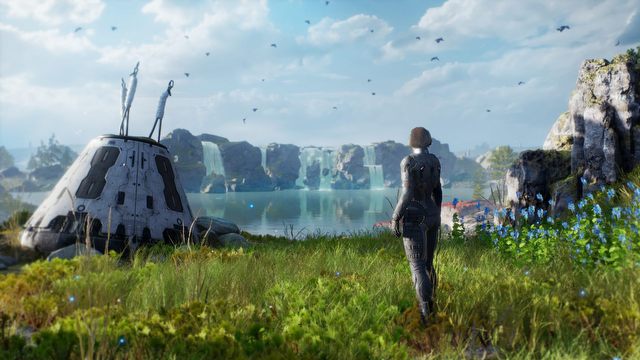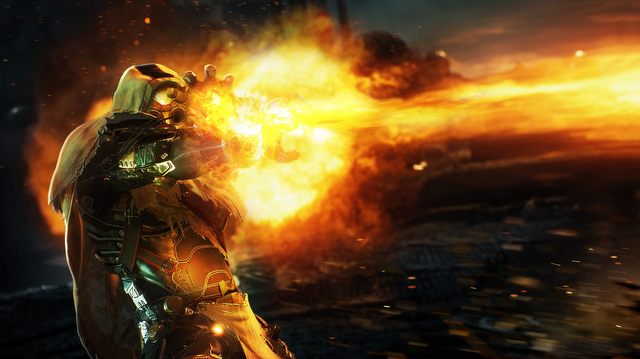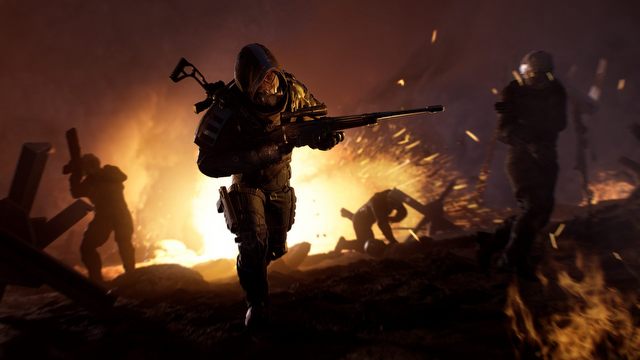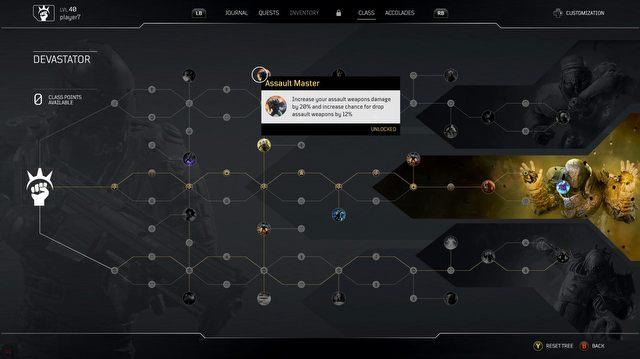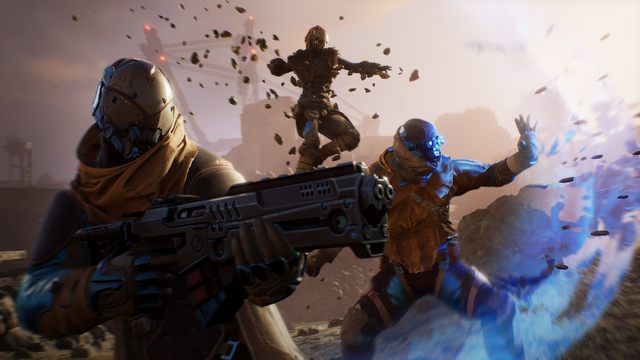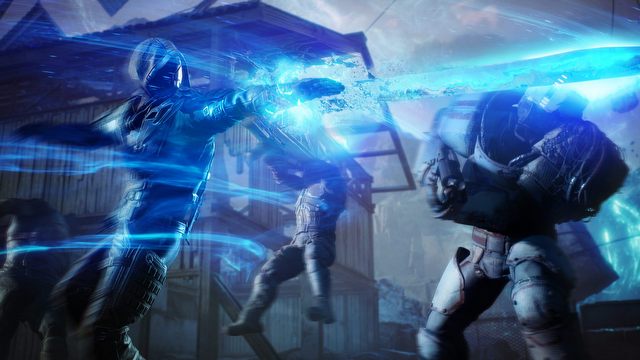Outriders Preview – No Pain No Gain!
"I've seen the Outriders preview." I brag to people, but nobody knows what Outriders is. They will soon find out, because although launching a new brand in 2020 is not easy, it is definitely worth trying and celebrating such attempts.
Of course, People Can Fly is a studio that probably needs no introduction. Under Adrian Chmielarz, this developer created the excellent Painkiller, and then Bulletstorm, both of which are among my favorite shooters. Today's People Can Fly, which has not only developed additional content for the Gears of War series, but also worked on Fortnite, is quite a different studio. After leaving the auspice of Epic Games and reinstating independence, the developer begins a new chapter with a new game.
This is a three-person cooperative shooter with a strong emphasis on collecting loot. A shooter that, in theory, wants to be similar to Destiny, but at the same time breaks away from the practice of similar "gamevices," and also brings the signature intensity People Can Fly's games are known for. This is what Outriders aspires to achieve. The question is, will this be a game to remember? After all, the market for such games has been rather saturated, and there are some examples illustrating that aggressive marketing is not enough to guarantee success. After playing a few hours of the early version, I can say that the developers are on the right track, although it does not always hit the sweet spot.
What did we see in the demo?
We got the opportunity to play the game's prologue, which, as the developers noted, was still work-in-progress (creating the beginning of the game at the end of development is a fairly common thing). Additionally, we could explore parts of the first game city and the surrounding desert area, where we had to break through to a tower with a solar power plant. In the final stage, we encountered a boss, the Guardian, who had been "altered" by the force of an anomaly. Some of the game's subsystems, such as crafting, were not available, but we could test many others.
In pursuit of a signal
Outriders is one of those games in which characters with perfectly trimmed hairstyles are thrown into the maelstrom of the struggle for the survival of the entire human race. Earth is ruined, so humanity sends two colony ships into space, to the lush planet Enoch. Only one makes it, and the colonization process begins.
Contrary to what the beginning of the prologue suggests, this, however, will not be a space farming simulator. The eponymous Outriders, that is elite soldiers and explorers, discover a mysterious signal on the planet and decide to investigate it. However, on the way to the source, a strange storm breaks out, which literally dissolves all encountered life into organic goo. Our hero, only brushed by the mysterious power, acquires powerful abilities, but has to retreat to the ship in the face of a cataclysm, where he enters cryosleep.
The adventure proper begins thirty years later, when he wakes up and finds that the anomaly has turned part of the planet into an apocalyptic desert, and the remaining colonists are still fighting a fierce battle for survival. Things are further complicated by the fact that the protagonist is not only person to have acquired peculiar skills; many other people have also, and they're now harassing local communities. Although we will initially be helping old friends, the main goal of the game is to reach the specified signal source, in the hope of learning the secrets of the alien world.
People Can Fly maintain that their new game is primarily an RPG, with combat implemented as in a shooter. You can argue with this theorem, because a lot depends on semantics and what definitions we will use. We know for a fact, however, that elements such as a side story, a dialogue and character development systems, will be an important part of the whole.
I'm not going to evaluate the quality of the story at this point. An interesting element of it, however, is the fact that the protagonist spends the 30 years in sleeping in cryo, and so all his friends are now older than him. A funny thing is that his character distinctly changes; in the prologue, he's rather timid and quite sympathetic. After the "time travel," he becomes boorish and seems completely different. Perhaps this is just my impression, but it seems cryogenic sleep can definitely change the character.
The entire gameplay is organized around typical hubs, where we can relax, work on improving items and characters, and look for new quests. The maps themselves, at least those shown in the demo, consisted mostly of bigger arenas connected with narrow passages. From time to time, I could stumble upon some hidden loot, and side quests played out in a more remote area (one of these was about eliminating a gang residing in a nearby bunker). So, there is no open world, the locations are relatively compact, filled with enemies, quests and loot. At the same time, PCF guarantee that their game will not take the profitable, but morally ambiguous path of game-service. This means no random rewards and no pay-to-win.
POLISH ACCENT IN POLISH GAME
Outriders' Polish pedigree will be evidenced by a character named Jakub. About the first thing he says is "kurwa," a graceful Polish invective. In one of the cut-scenes, he also pours three shots of booze for him and his friends, and promptly drinks it all himself. "This is just a wink at the Polish audience, we are not going to laugh at Polish vices," the developers assure.
There's no medic on this battlefield
Outriders is expected to offer four character classes to choose from, of which we've seen three (side note: there is character creation).
- The Devastators can strengthen their body with protective armor, cause shock waves by slamming the ground, or make quick dashes towards enemies.
- The Pyromancer sets things on fire, and derives power from the element. Pyromancers can turn enemies into a time-delay bomb that makes them explode after death.
- The Trickster, in addition to teleporting, can slow time down. One of his abilities creates a sphere in which everything except the players moves slower. This first and foremost, is a great move in tactical terms, because you can use the sphere, for example, to immobilize a boss, and give the team a break to regroup. The bullet time is obviously quite impressive visually, as you can observe bullets and parts of bodies of smashed enemies fly in the air from within the time bubble. And so another hallmark of PCF's games, the brutality, is also there. Especially in the glamorous slow-mo.
Initially, each character has a very limited range of skills. However, every few levels we get new skills – there were a total of eight for each class, and it was possible to have three active at any given time. In most cases, these are novel ways to deal damage, additional tactical capabilities, as well as healing abilities. That's right, every character has to mind their own health bars, as there isn't a healer-type class as of now.
Scoring a level also yields class skill points, which can be used to develop skills on a tree branching into three specializations. Browsing the trees reveals that most of the abilities boils down to small increases of statistics or damage from specific weapons. So it's the calculus-based kind of character development, and you need to like this particular style to enjoy it. If not, you can always check our detailed guide for the game, which is bound to appear as soon as the game's released.
The entire game can be completed in a three-person team, and there will be numerous co-op systems at play that will make it easier to move around or trigger missions. Each team member can offer to move to another location or go on a mission, and the remaining two can vote on that. Playing alone, we won't get any AI-controlled teammates, but the game should be balanced in a way that allows coping and at the same time enjoying the game. This also implies the self-sufficiency of each of the classes, which are not particularly specialized. How well that works in practice is, for now, an open question.
I played with each of them a little, and the differences were pretty apparent. I liked Pyromancer the most, whom I set to maximum arson mode by throwing three area-of-effect skills and just ramming as many enemies at a time as possible. It was quite fun, although other classes also have a couple of aces up their sleeves. For example: Tricksters have abilities that allow them to quickly get behind the enemy, and hence gain advantage and different bonuses.
TREATMENT BY MURDER
An interesting system in Outriders is the idea of healing characters through offensive actions. We can recover a smaller chunk of our HP by simply hiding from our opponents for a few seconds. But in order to restore the full health bar, each class must apply its own unique skill that can provide that. For example: the Destroyer is restored if an opponent dies next to it, and the Pyromancer when someone from the team finishes off an opponent set on fire.
Who needs shields?
People Can Fly is known for fast and beefy shooters, and that's what Outriders wants to be. This essentially is a shooter with some special abilities, which let us destroy superior enemy forces. The gunplay isn't bad – weapons sound good, and the bullets nicely pierce the opponents. The skills have the right power and look quite spectacular.
Of course, it is always difficult to refrain from certain clichés in such a game, so we will see some familiar "archetypes " of opponents: equipped with armor and with double life bars, armed with flamethrowers, or charging at players. These shortcomings are compensated by the boss fights, in which you need to focus and and cross the streams – otherwise the team will quickly fall.
Rainer, a secondary opponent could, for example, produce columns of fire that danced around the arena, and contact with them ended in quick death. The final boss, the aforementioned Guardian, also raised the pulse – he could escape trouble with teleportation and attack with electricity, like Emperor Palpatine. At a later stage of the battle, he also summoned a shield made of pieces of metal, behind which he restored life points. However, the most spectacular and dangerous attack was the "thunderstorm," which spread across the arena in several deadly circles. And in the first attempt we've actually failed, dazed by his crazy power.
Sort of like an MMO
Despite the fact that the game plays like a classic shooter, we can find some residual MMO mechanics, popular in games such as The Division or Destiny. Skills have cooldowns, opponents have life bars over their heads, along with different icons letting you know what effects apply to them. The telegraphs attacks across the area in clear circles and even shows the trigger bar for special attacks by more powerful enemies (giving you time to react). Needless to say, opponents and particularly bosses are also pretty tough, so you sometimes have to spare at least a few clips on them.
The player's dexterity is awarded, but the levels of the character or the equipment will still make a big difference. Collecting loot is one of the focuses of the game. The equipment, divided into classes denoted by colors such as gold and purple, will also be modifiable (we collect several types of raw materials in the game). Weapon modifiers can increase damage, as well as add effects such as toxic bullets dealing dps.
There is one inaccuracy in all this intelligently designed combat mechanics, possibly due to an early stage of the production. Most of the maps contain dozens of covers like sandbags or walls. The game utilizes a cover system akin to that from Gears of War. Over the course of a few hours, we barely used this feature. That's because the game in its current form promotes offensive – staying in motion, near the opponents was the best strategy. In the end, all the classes heal themselves, and skills are mostly triggered in direct vicinity of enemies. My guess is that this may change with the increasing difficulty of the game – perhaps then the defensive will become more important.
At the moment, however, the enemies are the only ones hiding behind walls, while players strive for maximum-contact gameplay. The difficulty level itself is kind of curious, by the way – it's presented as World Tier. Each subsequent level increases your chances of getting better items, but also increases your opponents' stats and abilities. In theory, this should encourage you to go back to earlier stages to try to handle more powerful versions of your opponents.
DIFFICULTY LEVEL ADAPTED TO THE GROUP
In single and multi-player games, there is often the problem of scaling the difficulty level to the size of the group. People Can Fly guarantees that we will get three game variants: for one, two, and three players. The game also includes quite a few amenities, like the ability to skip videos or vote when choosing a task, or changing locations. Each battlefield contains banners that can be used for fast travel.
When it clicks
I admit that I didn't really find Outriders as engrossing as I'd hoped on the first approach. I tried individual weapons because there must be a dozen of them – pistols to shotguns and rifles to snipers. I played with classes and the skills assigned to them. Together with the team, we also successfully broke through all the enemy systems. However, I didn't feel any particular longing for the game after leaving the presentation.
Initially, Outriders seemed a solid, but not outstanding co-op shooter set in a sci-fi world. Pleasant in its immediacy, brutality, and simple structure, while also providing minor diversions, such as boss fights that require more attention. But it's biggest complex is perhaps that it's "just another game" – and that's next to the worst thing in a world, in which we can play games like Destiny 2 or Warframe for free
Situation changed dramatically, however, when we found a subconscious connection with my team and decided to do the stupidest possible thing: instead of going through the demo all over again, we started repeating the first side mission called 'Bad Day' over and over again to get as high a character level as possible, as well as increasing the difficulty level of the game world. A dozen passes of this simple quest later, we were already in the zone – optimizing the passage of the mission, tweaking the character settings and collecting all the best equipment. It was only when we scored a level so high that one of the developers asked us to stop – because the demo was not adapted for it – that I saw the Outriders that could indeed engross a great many players.
The opponents started to pose a real threat, and there were more of them, so you had to stay on the ball all the time. Especially since at least one miniboss apparently got an additional attack after we've raised the World Tier. The loot also got sexier – I saw a rifle that randomly caused lightning strikes. It took us a while to beat the final boss, but it was more satisfying because even though we were in control of the situation, we had to be on our guard all the time. This is the real face of Outriders – fast, brutal, challenging and spectacular.
Perhaps presenting only the beginning of a game that's focused on a complex system of difficulty progression and a lots of loot does not fully reflect its true nature. There's definitely a lot of potential here, but you need to spend some time to get it. I think it's a question of getting the right balance of difficulty – or just playing with the right team. Players that like dynamic games should be satisfied. The graphics are pretty impressive, I particularly enjoyed the color palette and the the lighting, as well as some of the special attacs, including the slow-mo I mentioned, and Pyro's incendiarism.
On the other hand, animations and character models looked rather cheap at times Of course, it is difficult to evaluate all these things at the moment, and the devs still have plenty of time, but one thing is sure: tech websites will have a field day. After all, this is one of the intergenerational titles-the developers have already confirmed that we will see Outriders also on the PlayStation 5 and Xbox Series X.
CHALLENGES AND ACHIEVEMENTS
As befits a modern game, the main system of getting experience and collecting equipment will be supported by different types of challenges. There will be thousands, and they'll involve using certain types of weapons, killing different types of opponents, or using class skills.
The harder, the better
Outriders seems to be a game tailored for players who like fast action, lots of shooting, and constant new challenges complete with an increasingly high level of difficulty. Despite the assurances of the creators, it's hard to shake off the impression that this is an attempt to jump on the bandwagon of "gamevices," for which the release day is merely the beginning – loot generation and the challenges can fuel it for moths, or even years thereafter.
The foundations for this form of fun are definitely here. On the other hand, People Can Fly want to stay true to their legacy, and give the world a beefy shooter, in which guts and bullets fly around in glamorous slow-mo. For now, I can't say they've been completely successful in combining these two worlds – at times, I felt absolutely nothing when playing the game.
It felt like a typical shooter with enemies who have too many HP. The longer we played, the more the difficulty level increased, and the more pace we imposed on ourselves, the better the game got, because the right tabs of the mechanism were placed in the right places. The train really started rolling; the combat became brutal and chaotic, fueled by the desire to get a rifle that causes lightning bolts with every shot.
The uncertainty in such games obviously fuels the recent Anthem fiasco, a game with a somewhat similar sinusoid of emotions. Sometimes it was fun, other times it was boring. However, I hope that Outriders will come out straight and tweak their mechanics a bit. For now, we have a chance for a really good game that may stick around for a while.
DISCLAIMER
The expenses related to the trip for the game's private presentation were covered by us.
